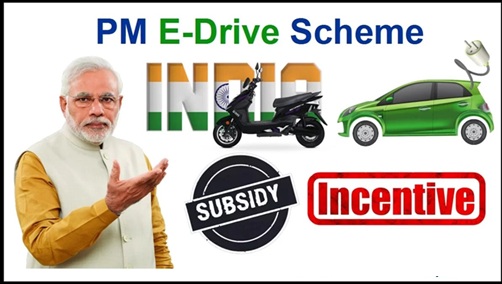(Prelims: Current Affairs)
(Mains, General Studies Paper 2: Issues arising from government policies and interventions for development in various sectors and their design and implementation.) |
Context
The Government of India issued guidelines on September 28, 2025, under the PM E-DRIVE Scheme to promote electric vehicles (EVs), which provide up to 100% subsidy for EV charging stations, battery swapping stations, and battery charging stations.

PM E-DRIVE: 100% Subsidy Initiative
- A budget of ₹10,000 crore has been allocated under the PM E-DRIVE Scheme (Prime Minister Electric Drive Revolution in Innovative Vehicle Enhancement), of which ₹2,000 crore is for charging infrastructure.
- The scheme began on October 1, 2024, and will run until March 31, 2026.
- It aims to accelerate EV adoption, promote local manufacturing, and reduce dependence on fuel imports.
- The subsidy scheme specifically encourages the installation of charging infrastructure to reduce range anxiety.
- The new guidelines provide up to 100% subsidy for EV charging stations, battery swapping stations, and battery charging stations.
Features
- Scope of subsidy:
- Upstream infrastructure: This includes distribution transformers, low-/high-voltage cables, distribution boxes, circuit breakers/isolators, mounting structures, fencing, and civil work.
- EV supply equipment (EVSE): This includes EV chargers and charging guns. In some cases, EVSE costs will also be subsidized.
- 100% subsidy in government buildings, schools, hospitals, and residential colonies with public access.
- 80% subsidy on upstream infrastructure and 70% subsidy on EVSEs in high-traffic locations (railway stations, airports, bus depots, metro stations, toll plazas).
- Eligible entities:
- Central government ministries (Petroleum and Natural Gas, Road Transport and Highways, Health, Energy, Housing and Urban Affairs, Railways, Civil Aviation, Steel, Ports), Central Public Sector Enterprises (CPSEs), and State/Union Territory PSUs.
- Nominal entities: IOCL, BPCL, HPCL, NHAI, AAI, SAIL, CONCOR, CESL, and Metro Rail Corporations.
- These entities will aggregate demand through nodal agencies and identify locations for charging stations.
- Location priority:
- Cities with a population of more than 1 million as per Census 2011.
- Smart cities notified by the Ministry of Housing and Urban Affairs (MoHUA).
- Satellite cities connected to seven major metros (Delhi, Mumbai, Kolkata, Chennai, Hyderabad, Bengaluru, Ahmedabad).
- Capitals of all states/union territories and cities identified under the National Clean Air Programme (NCAP).
- Inter-city and inter-state highways, which will be selected in consultation with the Ministry of Road Transport and Highways (MoRTH).
- Implementation: Entities can install charging stations directly or appoint a charge point operator (CPO).
Impact on the EV market
- Increased confidence: Widespread availability of charging stations will boost consumerconfidence, leading to increased demand for EVs.
- Market growth: EV sales in India will accelerate, especially in e-2W (10% market share target by 2026) and e-3W (15% target).
- Economic benefits: Boost local manufacturing, job creation, and reduced dependence on fuel imports.
- Environmental benefits: Reduced carbon emissions, which will support the Net-Zero 2070 target.
- Industry development: Incentives for businesses (CPOs, equipment manufacturers) related to charging infrastructure.
|
About the PM E-DRIVE Scheme
The PM E-DRIVE Scheme is the successor to the FAME-II scheme and is designed to accelerate EV adoption. Key aspects:
- Budget: ₹10,000 crore, of which ₹2,000 crore is for charging infrastructure.
- Duration: October 1, 2024, to March 31, 2026
Objective:
- Install 72,300 public EV chargers (22,100 fast chargers for e-4W, 1,800 bus chargers, 48,400 e-2W/e-3W chargers).
- Demand incentives for e-2W, e-3W, e-4W, e-buses, and e-ambulances.
- Modernization of EV testing infrastructure.
- Key features:
- Demand incentives: ₹10,000 per vehicle for e-2W (until March 2025), ₹50,000 for e-3W (half the amount from April 2025).
- ₹500 crore for e-ambulances.
- Promotion of the circular economy, especially for battery recycling.
- Impact: Incentivizing 3.2 lakh e-3Ws, strengthening the supply chain, and promoting clean transportation.
|



